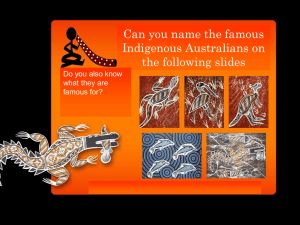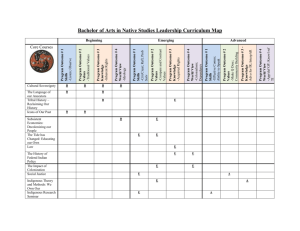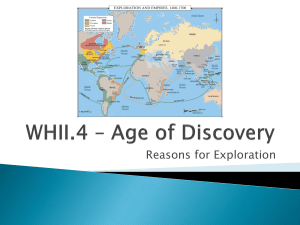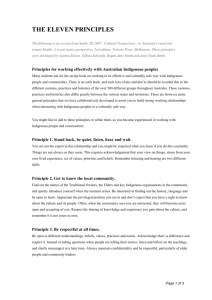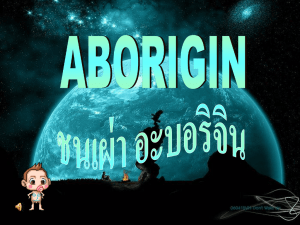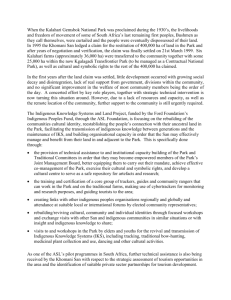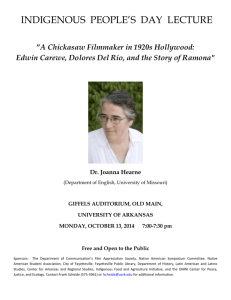Media release - Latest Report on Indigenous Expenditure
advertisement
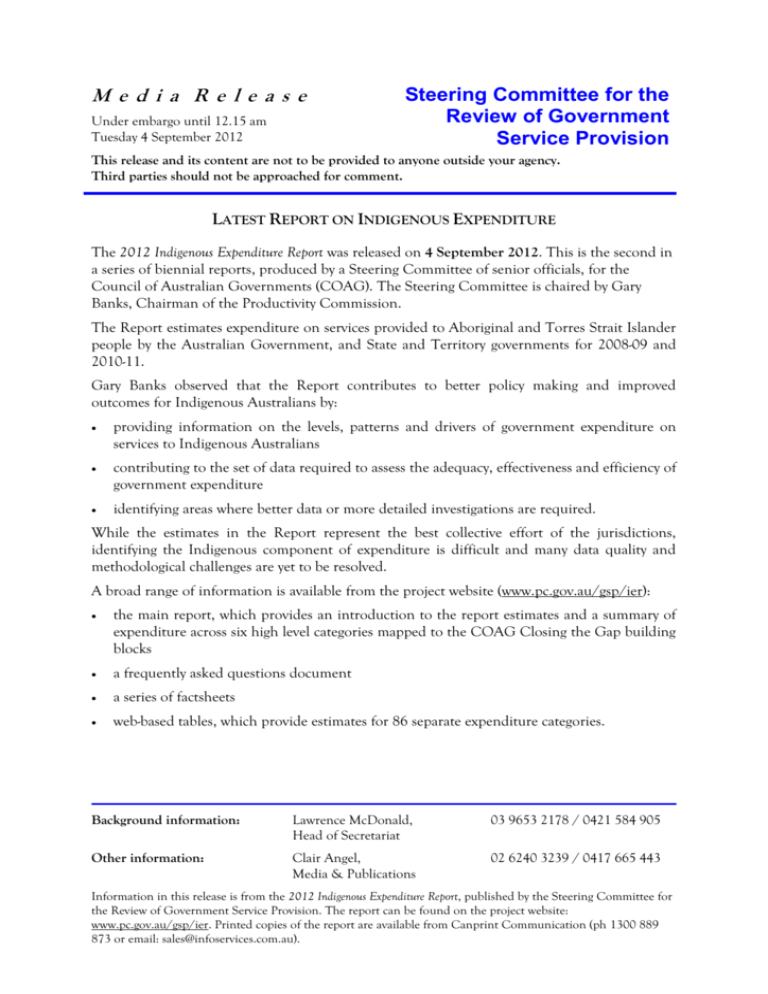
Media Release Under embargo until 12.15 am Tuesday 4 September 2012 Steering Committee for the Review of Government Service Provision This release and its content are not to be provided to anyone outside your agency. Third parties should not be approached for comment. LATEST REPORT ON INDIGENOUS EXPENDITURE The 2012 Indigenous Expenditure Report was released on 4 September 2012. This is the second in a series of biennial reports, produced by a Steering Committee of senior officials, for the Council of Australian Governments (COAG). The Steering Committee is chaired by Gary Banks, Chairman of the Productivity Commission. The Report estimates expenditure on services provided to Aboriginal and Torres Strait Islander people by the Australian Government, and State and Territory governments for 2008-09 and 2010-11. Gary Banks observed that the Report contributes to better policy making and improved outcomes for Indigenous Australians by: providing information on the levels, patterns and drivers of government expenditure on services to Indigenous Australians contributing to the set of data required to assess the adequacy, effectiveness and efficiency of government expenditure identifying areas where better data or more detailed investigations are required. While the estimates in the Report represent the best collective effort of the jurisdictions, identifying the Indigenous component of expenditure is difficult and many data quality and methodological challenges are yet to be resolved. A broad range of information is available from the project website (www.pc.gov.au/gsp/ier): the main report, which provides an introduction to the report estimates and a summary of expenditure across six high level categories mapped to the COAG Closing the Gap building blocks a frequently asked questions document a series of factsheets web-based tables, which provide estimates for 86 separate expenditure categories. Background information: Lawrence McDonald, Head of Secretariat 03 9653 2178 / 0421 584 905 Other information: Clair Angel, Media & Publications 02 6240 3239 / 0417 665 443 Information in this release is from the 2012 Indigenous Expenditure Report, published by the Steering Committee for the Review of Government Service Provision. The report can be found on the project website: www.pc.gov.au/gsp/ier. Printed copies of the report are available from Canprint Communication (ph 1300 889 873 or email: sales@infoservices.com.au). Key points The 2012 Report is the second in a series that provides estimates of expenditure on services to Indigenous Australians. It contributes to the information available to policy makers to address the gap between outcomes for Indigenous and other Australians. It provides information on the level and patterns of expenditure on targeted and mainstream services for Indigenous Australians across 86 expenditure categories, mapped to the COAG National Indigenous Reform Agreement building blocks. When combined with other information, the estimates in the Report can contribute to a better understanding of the adequacy, effectiveness and efficiency of government expenditure on services to Indigenous Australians. Some national level data are summarised below. There were significant variations in levels and patterns of expenditure across expenditure categories and across states and territories — more information is available in the Report and from the project website (www.pc.gov.au/gsp/ier). Total direct Indigenous expenditure in 2010-11 was estimated to be $25.4 billion, accounting for 5.6 per cent of total direct general government expenditure. Indigenous Australians make up 2.6 per cent of the population. The Australian Government accounted for $11.5 billion (45 per cent) of Indigenous direct expenditure, with the remaining $13.9 billion (55 per cent) provided by State and Territory governments. Mainstream services accounted for $19.9 billion (78 per cent) of Indigenous direct expenditure, with the remaining $5.5 billion (22 per cent) provided through targeted (Indigenous specific) services. Estimated expenditure per head of population was $44 128 for Indigenous Australians, compared with $19 589 for other Australians (a ratio of 2.25:1). The $24 538 per person difference reflected the combined effects of: greater intensity of service use ($16 110 or 66 per cent) — Indigenous Australians use more services per capita because of greater need, and because of population characteristics such as the younger age profile of the Indigenous population additional costs of providing services ($8429 or 34 per cent) — it can cost more to provide services to Indigenous Australians if mainstream services are more expensive to provide (for example, because of location), or if Indigenous Australians receive targeted services (for example liaison officers in hospitals) in addition to mainstream services. The Report includes a number of focus areas of expenditure. In selected areas, the ratio of Indigenous to non-Indigenous expenditure per head of population was: school education — 2.99:1 ($5359 per Indigenous Australian compared with $1792 per nonIndigenous Australian), mainly reflecting higher per capita use of school services, driven by the younger age profile of the Indigenous population. public and community health services — 4.89:1 ($3152 per Indigenous Australian compared with $644 per non-Indigenous Australian), mainly reflecting higher per capita use of health services, driven by the poorer health status of Indigenous Australians housing — 4.85:1 ($1708 per Indigenous Australian compared with $352 per non-Indigenous Australian), mainly reflecting higher per capita use of social housing by Indigenous Australians, driven by socio-economic disadvantage. [END]
